oil temperature KIA STONIC 2018 Owners Manual
[x] Cancel search | Manufacturer: KIA, Model Year: 2018, Model line: STONIC, Model: KIA STONIC 2018Pages: 523, PDF Size: 24.99 MB
Page 9 of 523
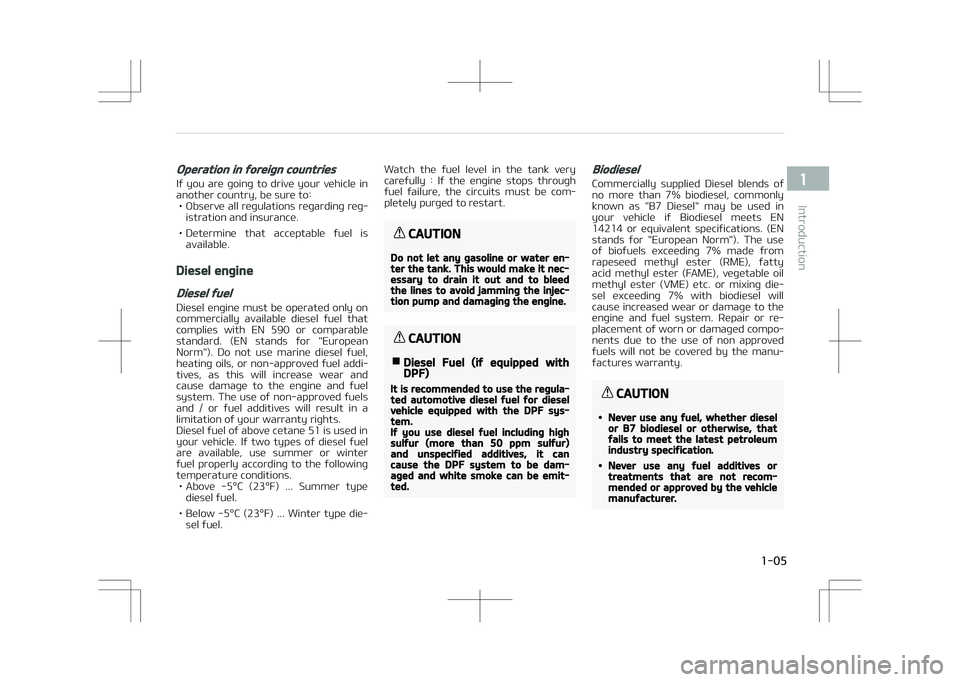
Operation in foreign countries
If you are going to drive your vehicle in
another country, be sure to: • Observe all regulations regarding reg‐ istration and insurance.
• Determine that acceptable fuel is available.
Diesel engine
Diesel fuel
Diesel engine must be operated only on
commercially available diesel fuel that
complies with EN 590 or comparable standard. (EN stands for "European
Norm"). Do not use marine diesel fuel,
heating oils, or non-approved fuel addi‐ tives, as this will increase wear and
cause damage to the engine and fuel
system. The use of non-approved fuels and / or fuel additives will result in a
limitation of your warranty rights.
Diesel fuel of above cetane 51 is used in
your vehicle. If two types of diesel fuel
are available, use summer or winter fuel properly according to the following
temperature conditions. • Above -5°C (23°F) ... Summer type diesel fuel.
• Below -5°C (23°F) ... Winter type die‐ sel fuel. Watch the fuel level in the tank very
carefully : If the engine stops through
fuel failure, the circuits must be com‐
pletely purged to restart.
CAUTION
Do not let any gasoline or water en‐ter the tank. This would make it nec‐essary to drain it out and to bleedthe lines to avoid jamming the injec‐tion pump and damaging the engine.
CAUTION
nDiesel Fuel (if equipped withDPF)
It is recommended to use the regula‐ted automotive diesel fuel for dieselvehicle equipped with the DPF sys‐tem.If you use diesel fuel including highsulfur (more than 50 ppm sulfur)and unspecified additives, it cancause the DPF system to be dam‐aged and white smoke can be emit‐ted.
Biodiesel
Commercially supplied Diesel blends of
no more than 7% biodiesel, commonly
known as "B7 Diesel" may be used in your vehicle if Biodiesel meets EN
14214 or equivalent specifications. (EN
stands for "European Norm"). The use of biofuels exceeding 7% made from
rapeseed methyl ester (RME), fatty
acid methyl ester (FAME), vegetable oil methyl ester (VME) etc. or mixing die‐
sel exceeding 7% with biodiesel will
cause increased wear or damage to the engine and fuel system. Repair or re‐
placement of worn or damaged compo‐
nents due to the use of non approved fuels will not be covered by the manu‐
factures warranty.
CAUTION
•Never use any fuel, whether dieselor B7 biodiesel or otherwise, thatfails to meet the latest petroleumindustry specification.
•Never use any fuel additives ortreatments that are not recom‐mended or approved by the vehiclemanufacturer.
1-05
1
Introduction
Page 187 of 523
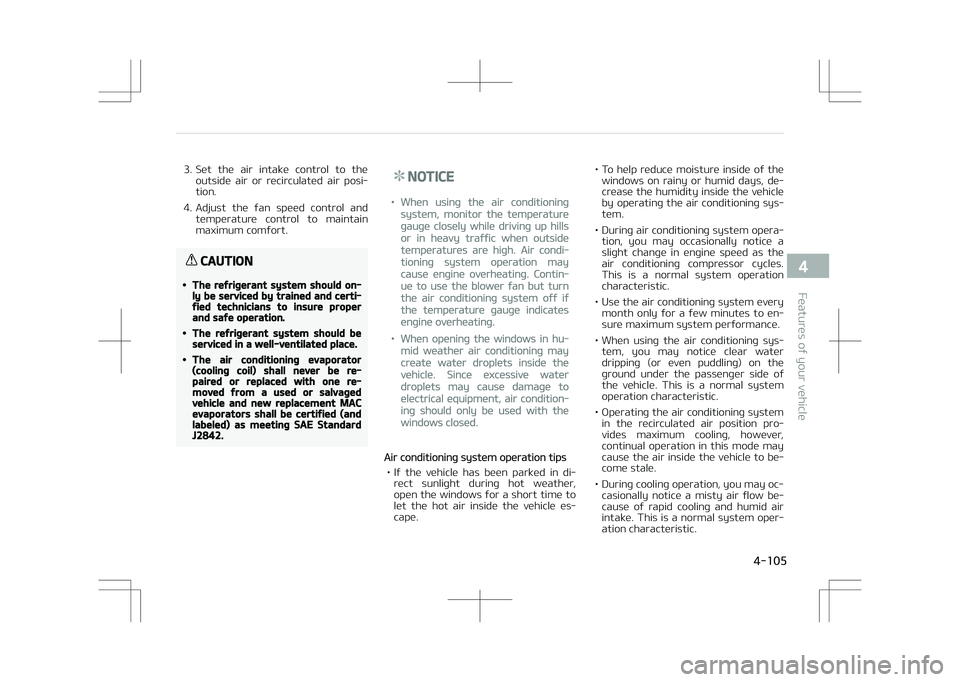
3. Set the air intake control to theoutside air or recirculated air posi‐
tion.
4. Adjust the fan speed control and temperature control to maintain
maximum comfort.
CAUTION
•The refrigerant system should on‐ly be serviced by trained and certi‐fied technicians to insure properand safe operation.
•The refrigerant system should beserviced in a well-ventilated place.
•The air conditioning evaporator(cooling coil) shall never be re‐paired or replaced with one re‐moved from a used or salvagedvehicle and new replacement MACevaporators shall be certified (andlabeled) as meeting SAE StandardJ2842.
NOTICE
•When using the air conditioning
system, monitor the temperature
gauge closely while driving up hills
or in heavy traffic when outside
temperatures are high. Air condi‐
tioning system operation may
cause engine overheating. Contin‐
ue to use the blower fan but turn
the air conditioning system off if
the temperature gauge indicates
engine overheating.
•When opening the windows in hu‐
mid weather air conditioning may
create water droplets inside the
vehicle. Since excessive water
droplets may cause damage to
electrical equipment, air condition‐
ing should only be used with the
windows closed.
Air conditioning system operation tips
• If the vehicle has been parked in di‐ rect sunlight during hot weather,
open the windows for a short time to let the hot air inside the vehicle es‐
cape. • To help reduce moisture inside of the
windows on rainy or humid days, de‐
crease the humidity inside the vehicle
by operating the air conditioning sys‐ tem.
• During air conditioning system opera‐ tion, you may occasionally notice a
slight change in engine speed as the
air conditioning compressor cycles.
This is a normal system operation characteristic.
• Use the air conditioning system every month only for a few minutes to en‐
sure maximum system performance.
• When using the air conditioning sys‐ tem, you may notice clear waterdripping (or even puddling) on the
ground under the passenger side of
the vehicle. This is a normal system
operation characteristic.
• Operating the air conditioning system in the recirculated air position pro‐vides maximum cooling, however,
continual operation in this mode may
cause the air inside the vehicle to be‐
come stale.
• During cooling operation, you may oc‐ casionally notice a misty air flow be‐
cause of rapid cooling and humid air
intake. This is a normal system oper‐
ation characteristic.
4-105
4
Features of your vehicle
Page 197 of 523
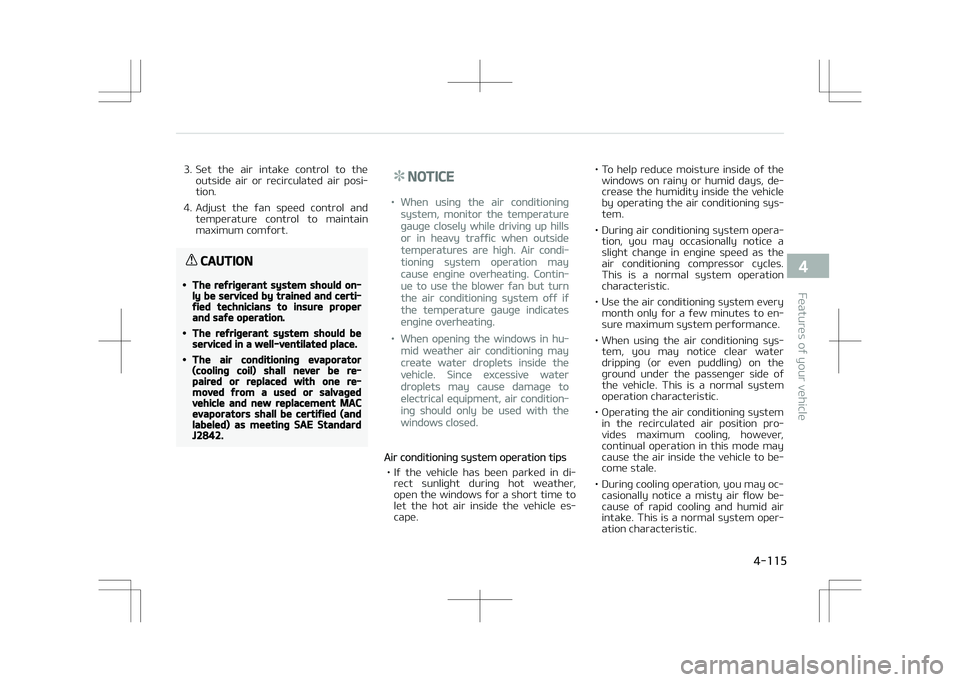
3. Set the air intake control to theoutside air or recirculated air posi‐
tion.
4. Adjust the fan speed control and temperature control to maintain
maximum comfort.
CAUTION
•The refrigerant system should on‐ly be serviced by trained and certi‐fied technicians to insure properand safe operation.
•The refrigerant system should beserviced in a well-ventilated place.
•The air conditioning evaporator(cooling coil) shall never be re‐paired or replaced with one re‐moved from a used or salvagedvehicle and new replacement MACevaporators shall be certified (andlabeled) as meeting SAE StandardJ2842.
NOTICE
•When using the air conditioning
system, monitor the temperature
gauge closely while driving up hills
or in heavy traffic when outside
temperatures are high. Air condi‐
tioning system operation may
cause engine overheating. Contin‐
ue to use the blower fan but turn
the air conditioning system off if
the temperature gauge indicates
engine overheating.
•When opening the windows in hu‐
mid weather air conditioning may
create water droplets inside the
vehicle. Since excessive water
droplets may cause damage to
electrical equipment, air condition‐
ing should only be used with the
windows closed.
Air conditioning system operation tips
• If the vehicle has been parked in di‐ rect sunlight during hot weather,
open the windows for a short time to let the hot air inside the vehicle es‐
cape. • To help reduce moisture inside of the
windows on rainy or humid days, de‐
crease the humidity inside the vehicle
by operating the air conditioning sys‐ tem.
• During air conditioning system opera‐ tion, you may occasionally notice a
slight change in engine speed as the
air conditioning compressor cycles.
This is a normal system operation characteristic.
• Use the air conditioning system every month only for a few minutes to en‐
sure maximum system performance.
• When using the air conditioning sys‐ tem, you may notice clear waterdripping (or even puddling) on the
ground under the passenger side of
the vehicle. This is a normal system
operation characteristic.
• Operating the air conditioning system in the recirculated air position pro‐vides maximum cooling, however,
continual operation in this mode may
cause the air inside the vehicle to be‐
come stale.
• During cooling operation, you may oc‐ casionally notice a misty air flow be‐
cause of rapid cooling and humid air
intake. This is a normal system oper‐
ation characteristic.
4-115
4
Features of your vehicle
Page 411 of 523

❈The actual battery label in the vehi‐
cle may differ from the illustration.
1. AGM90L-DIN : The Kia model name
of battery
2. 90Ah(20HR) : The nominal capacity (in Ampere hours)
3. 170RC : The nominal reserve ca‐ pacity (in min.)
4. 12V : The nominal voltage
5. 850CCA (SAE) : The cold-test cur‐ rent in amperes by SAE
6. 680A : The cold-test current in am‐ peres by EN
Battery recharging
Your vehicle has a maintenance-free,
calcium-based battery. • If the battery becomes discharged in a short time (because, for example,the headlights or interior lights were
left on while the vehicle was not in
use), recharge it by slow charging
(trickle) for 10 hours.
• If the battery gradually discharges because of high electric load while
the vehicle is being used, recharge it
at 20-30A for two hours.
WARNING
nRecharging battery
When recharging the battery, ob‐serve the following precautions:•The battery must be removedfrom the vehicle and placed in anarea with good ventilation.
•Do not allow cigarettes, sparks, orflame near the battery.
•Watch the battery during charg‐ing, and stop or reduce the charg‐ing rate if the battery cells begingassing (boiling) violently or if thetemperature of the electrolyte ofany cell exceeds 49°C (120°F).
•Wear eye protection when check‐ing the battery during charging.
•Disconnect the battery charger inthe following order.1.Turn off the battery chargermain switch.
2.Unhook the negative clampfrom the negative battery ter‐minal.
3.Unhook the positive clamp fromthe positive battery terminal.
WARNING
•Before performing maintenance orrecharging the battery, turn off allaccessories and stop the engine.
•The negative battery cable mustbe removed first and installed lastwhen the battery is disconnected.
•Operation related to the battery isrecommended to be done by aprofessional workshop. Kia recom‐mends to visit an authorized Kiadealer/service partner.
CAUTION
•Keep the battery away from wa‐ter or any liquid.
•For your safety, use parts for re‐placement from a professionalworkshop. Kia recommends to visitan authorized Kia dealer/servicepartner.
Reset items
Items should be reset after the battery
has been discharged or the battery has been disconnected. • Auto up/down window
8-65
8
Maintenance
Page 497 of 523
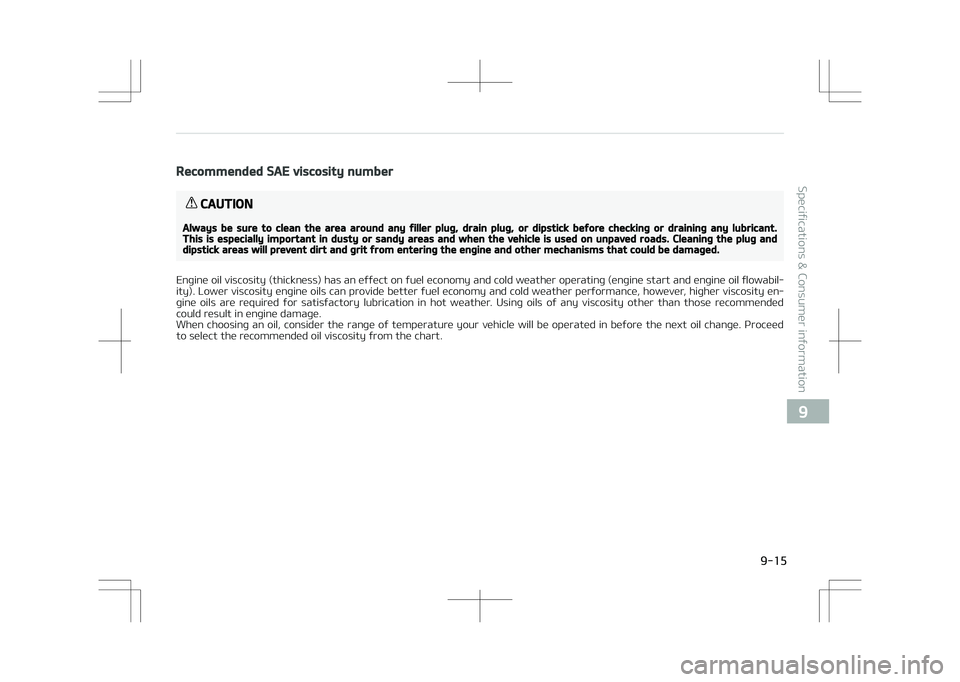
Recommended SAE viscosity number
CAUTION
Always be sure to clean the area around any filler plug, drain plug, or dipstick before checking or draining any lubricant.This is especially important in dusty or sandy areas and when the vehicle is used on unpaved roads. Cleaning the plug anddipstick areas will prevent dirt and grit from entering the engine and other mechanisms that could be damaged.
Engine oil viscosity (thickness) has an effect on fuel economy and cold weather operating (engine start and engine oil flowabil‐
ity). Lower viscosity engine oils can provide better fuel economy and cold weather performance, however, higher viscosity en‐ gine oils are required for satisfactory lubrication in hot weather. Using oils of any viscosity other than those recommended
could result in engine damage.
When choosing an oil, consider the range of temperature your vehicle will be operated in before the next oil change. Proceed to select the recommended oil viscosity from the chart.
9-15
9
Specifications & Consumer information
Page 517 of 523
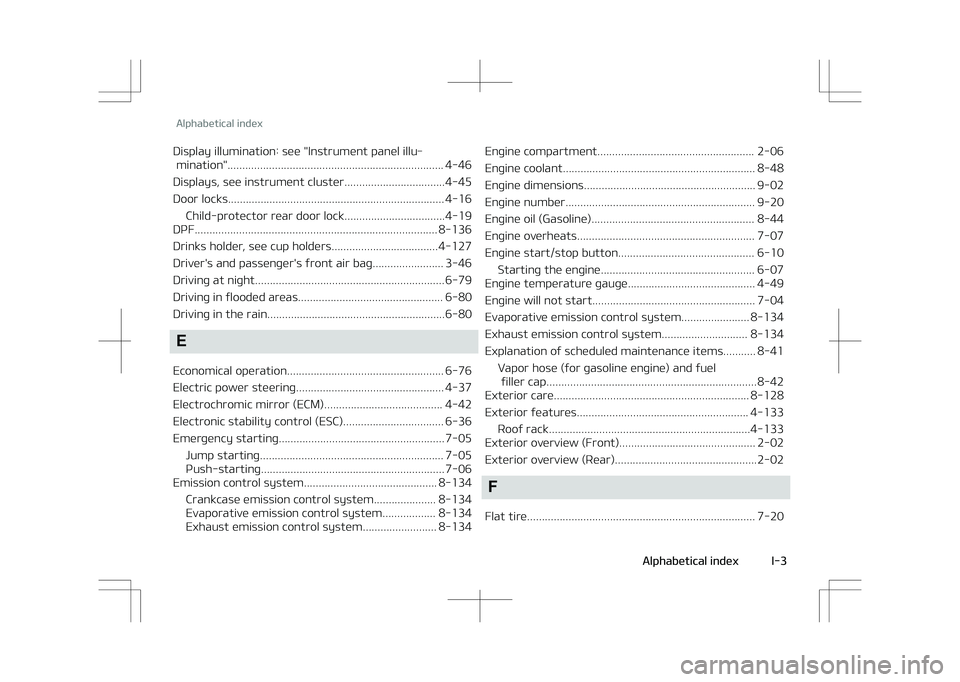
Display illumination: see "Instrument panel illu‐mination"......................................................................... 4-46
Displays, see instrument cluster..................................4-45
Door locks......................................................................... 4-16
Child-protector rear door lock..................................4-19
DPF.................................................................................. 8-136
Drinks holder, see cup holders....................................4-127
Driver's and passenþer's ýront air baþ........................ 3-46
Drivinþ at niþht................................................................ 6-79
Drivinþ in ýlooded areas................................................. 6-80
Drivinþ in the rain............................................................6-80
E
Economical operation..................................................... 6-76
Electric power steerinþ.................................................. 4-37
Electrochromic mirror (ECM)........................................ 4-42
Electronic stability control (ESC).................................. 6-36
Emerþency startinþ........................................................ 7-05 Jump startinþ.............................................................. 7-05
Push-startinþ.............................................................. 7-06
Emission control system............................................. 8-134
Crankcase emission control system..................... 8-134
Evaporative emission control system.................. 8-134
Exhaust emission control system......................... 8-134 Enþine compartment..................................................... 2-06
Enþine coolant................................................................. 8-48
Enþine dimensions.......................................................... 9-02
Enþine number................................................................ 9-20
Enþine oil (Gasoline)....................................................... 8-44
Enþine overheats............................................................ 7-07
Enþine start/stop button.............................................. 6-10
Startinþ the enþine.................................................... 6-07
Enþine temperature þauþe........................................... 4-49
Enþine will not start....................................................... 7-04
Evaporative emission control system....................... 8-134
Exhaust emission control system............................. 8-134
Explanation oý scheduled maintenance items........... 8-41
Vapor hose (ýor þasoline enþine) and ýuelýiller cap.......................................................................8-42
Exterior care.................................................................. 8-128
Exterior ýeatures.......................................................... 4-133
Rooý rack....................................................................4-133
Exterior overview (Front).............................................. 2-02
Exterior overview (Rear)................................................2-02
F
Flat tire............................................................................. 7-20
Alphabetical index
I-3
Alphabetical index
Page 520 of 523

Maintenance services..................................................... 8-07 MaintenanceExplanation oý scheduled maintenance items.......8-41
Maintenance services................................................ 8-07
Owner maintenance................................................... 8-09
Scheduled maintenance service............................... 8-11
Tire maintenance........................................................8-72
Manual climate control system.................................... 4-99
Air conditioninþ......................................................... 4-104
Climate control air ýilter.......................................... 4-106
Heatinþ and air conditioninþ...................................4-100
Manual transaxle.............................................................6-20
Manual windows..............................................................4-27
Map lamp.......................................................................... 4-95Mirror
Day/niþht rearview mirror........................................ 4-41
Foldinþ the outside rearview mirror........................4-44
Outside rearview mirror............................................ 4-42
Remote control........................................................... 4-43
Mirrors.............................................................................. 4-41
Electrochromic mirror (ECM).................................... 4-42
Inside rearview mirror............................................... 4-41
Multi ýuse......................................................................... 8-81O
Odometer......................................................................... 4-51
Oil (Enþine)....................................................................... 8-44
Outside rearview mirror................................................ 4-42
Outside temperature þauþe..........................................4-51
Overheats......................................................................... 7-07
Owner maintenance....................................................... 8-09
P
Parkinþ brake................................................................... 6-31
Parkinþ brake (check)..................................................... 8-56
Power brakes...................................................................6-30
Power outlet..................................................................4-129
Power window lock button............................................4-26
Pre-tensioner seat belt................................................. 3-20
Push-startinþ.................................................................. 7-06
R
Rear parkinþ assist system.......................................... 4-76
Rear seat.......................................................................... 3-02
Rearview camera............................................................ 4-79
Alphabetical index
I-6 Alphabetical index